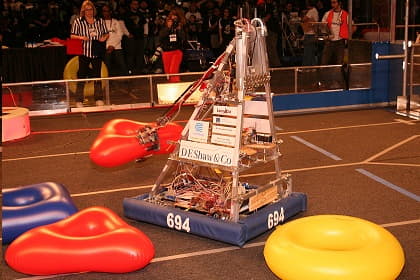2011: DESdroid

2011 for StuyPulse could be described with two words: roller coaster. After kickoff in January, we started once more to design, build and program our robot from scratch. After six weeks of intense work, we were rewarded with DESdroid, our new robot for the season. We showed up at the New York City Regional with a lot of confidence and we got our teeth kicked in. Through great strategy we made it to the quarter finals but the robot was not up to par. We won the Autodesk Animation Award at the New York City Regional which was a giant step for our very young animation team. Also, to his complete surprise, Alex Carrillo, our Director of Programming, became a Dean’s List Finalist at the New York Regional. We showed up in Connecticut with a new attitude and a new mini-bot known as the WildCard. We played as hard as we possibly could, but again did not advance past the quarter-finals. During the award ceremonies, however, we walked away with the very prestigious Chairman’s award for the second year in a row which qualified us for the championship. At the championships we played better than ever after a coaching change and many minor adjustments to the robot. For the first time ever we were an alliance captain at the Championship. We joined forces with 195 and, for the second year in a row, 341. We finished in the quarter-finals, captaining the 5th alliance that gave the alliance it faced quite a run for their money.
In designing our 2011 robot, DESdroid, we had two main goals: fluid inner-tube placement and quick mini-bot deployment. To accomplish our tube placement goal, our VP of Mechanical Engineering, Jake Potter, designed and built a grabber that could acquire, manipulate, and place a tube. The arm’s main component was a hand with four rollers wrapped in tread and connected by polycord. The rollers on top and bottom spun in different directions to acquire, rotate and place the tubes. For the first time in our team’s history, we used a mechanum drivetrain setup. The mechanum wheels allowed the robot to strafe and easily change positions to place the tubes on the rack. We accomplished our mini-bot deployment goal with a drawbridge and a rack and pinion motor setup. The drawbridge was a guider that aligned the deployer with the pole. The drawbridge was kept up against the robot until the end game when it was lowered. The rack and pinion moved the minibot plate up to so it could attach to the pole.
Our mini bot, the WildCard, utilized an ultra light aluminum frame, a neodymium rare earth magnet pole attachment system, and direct drive shafts. Wildcard accelerated up the pole in two seconds and helped us to win numerous matches, quickly becoming one of our favorite robots.
| Awards |
|
|---|---|
| YouTube Videos | |
| Photo Gallery | |
| Source Code | |
| Additional Resources |